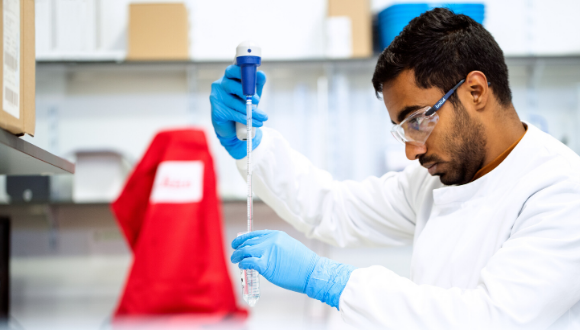Biosafety levels
Biosafety level designations are based on a composite of the design features, construction, containment facilities, equipment, practices and operational procedures required for working with agents from the various microorganisms risk groups
Laboratory facilities are designated as:
Biosafety Level 1: basic
Biosafety Level 2: basic
Biosafety Level 2+: BSL-2 laboratory with biosafety practices and procedures typically found at BSL-3
Biosafety Level 3: containment, as Level 2 plus special clothing, controlled access, directional airflow
Biosafety Level 4: maximum containment. As Level 3 plus airlock entry, shower exit, special waste disposal
For all Biosafety levels:
- Pipetting should be only with mechanical advice
- It is not permitted to eat or drink in the lab areas
- Do not seal the biohazard bags; leave them loosely closed (opening of at least 5 cm)
Biosafety level (BSL) |
BSL-1 |
BSL-2 |
BSL-2+ |
BSL-3 |
BSL-4 |
|---|---|---|---|---|---|
| Description | No containment Defined Unlikely to cause disease | Containment Moderate risk disease of varying severity | Laboratories working with BSL-2 microorganisms levels with biosafety practices of BSL-3 level | High containment Aerosol transmission Serious lethal/potentially disease | Maximum containment Exoctic, high risk agents Life-threatening disease |
| Organisms | E. coli, yeast | Mammalian cells, tissue culture work, blood, human fluids, patient specimens, Influenza, HSV, HIV, Salmonellae, Hepatitis B, Listeria, infected animals with BSL-2 agents, Lyme Disease | The risk assessment process, may determine that safety practices, over and above those required at BSL-2 needed for a research project, yet more complex BSL-3 laboratory facility is not necessary. Sars-Cov-2 for diagnostic (RT-PCR), blood from convalescence Covid-19 patients | Tuberculosis, Sars-Cov-2 in tissue culture | Ebola virus |
| Pathogen type | Agents that pose minimal hazard potential to laboratory personnel & environment | Agents associated with human disease | Sars-Cov-2 for diagnostic (RT-PCR), blood from convalescence Covid-19 patients |
Indiginous/exotic agents which present a potential aerosol trasmission, agents causing serious or potentially lethal diseases
|
Dangerous/Exotic agents that pose a high rusk of aerosol-transmitted laboratory infections, life-threatening disease |
|
Treatment
|
Prophylactic treatment available | Treatment available | Depends on the pathogen | ||
| Public access | Not recommended | Limit access to lab while BSL-2 work is being conducted | Restricted | The laboratory is separated from general traffic flow and accessed through an anteroom (double door entry or basic laboratory – Biosafety Level 2) or an airlock | Located in a separate building or in a clearly delineated zone within a secure building. Entry and exit of personnel and supplies must be through an airlock or pass-through system |
| Bench-top work | Permitted | Permitted only for low risk procedures | Not permitted | Not permitted | Not permitted |
| Personal protective equipment (PPE) | Lab coat, gloves | Lab coat, mask, gloves | Disposable lab coat, N95 or N99 masks, face shield or half face mask, double gloves, disposable hat | Protective clothing must be of the type with solid-front or wrap-around gowns, scrub suits, coveralls, head covering and, where appropriate, shoe covers, in addition to PPE in BSL-2 | Ventilated and reusable pressurised protective suit (deathly viruses) |
| Decontamination/disinfection | Autoclave and following any spill | Autoclave daily and following any spill | Autoclave dailly, immediately following work with biohazardous material, and following any spill | Pass-thru autoclave with bioseal in laboratory room | Pass-thru autoclave with bioseal in lab |
| Biological waste | Biohazard bag | Double biohazard bag | Double biohazard bag |
Laboratory room must be sealable for decontamination. Air-ducting systems must be constructed to permit gaseous decontamination. An autoclave for the decontamination of contaminated waste material should be available in the containment laboratory. If infectious waste has to be removed from the containment laboratory for decontamination and disposal, it must be transported in sealed, unbreakable and leakproof containers
|
A double-door, pass-through autoclave must be available in the laboratory area. Other methods of decontamination must be available for equipment and items that cannot withstand steam sterilization |
| Biological safety cabinet - BSC (HEPA Filter) | Not required | Required | Required for all work with biohazardous agents |
Biological safety cabinets should be sited away from walking areas and out of crosscurrents from doors and ventilation systems. The exhaust air from Class I or Class II biological safety cabinets, which will have been passed through HEPA filters, must be discharged in such a way as to avoid interference with the air balance of the cabinet or the building exhaust system
|
Class III biological safety cabinet, the supply air may be drawn from within the room through a HEPA filter mounted on the cabinet or supplied directly through the supply air system. Exhaust airfrom the Class III biological safety cabinet must pass through two HEPA filters prior to release outdoors. The cabinet must be operated at negative pressure to the surrounding laboratory at all times. A dedicated non-recirculating ventilating system for the cabinet laboratory is required
|
|
Hand washing facilities
|
Required
|
Required
|
Required (foot, elbow) |
Washing station with hands-free controls should be provided near each exit door |
Decontamination shower must be provided and used by personnel leaving the containment laboratory area. A separate personnel shower with inner and outer changing rooms is also provided |
| Storage equipment | No biohazard signs required | Biohazard signs required, all equipment must be labeled with contents | Biohazard signs required, all equipment must be labeled with contents | Biohazard signs required, all equipment must be labeled with contents | Biohazard signs required, all equipment must be labeled with contents |
| Physical containment | Decontaminate equipment immediately after use | Use physical containment devices during procedures that have a high potential to create aerosols when using biohazardous material; Decontaminate immediately after use | Use physical containment devices (centrifuge safety cup, sealed centrifuge rotor) for all activities using biohazardous material; Open containers in a BSC; Decontaminate immediately after use | Consideration should be given to equipment such as centrifuges, which will need additional containment accessories, for example, safety buckets or containment rotors. Some centrifuges and other equipment, such as cell-sorting instruments for use with infected cells, may need additional local exhaust ventilation with HEPA filtration for efficient containment |
Equipment such as centrifuges, will need safety buckets or containment rotors. Some centrifuges and other equipment, such as cell-sorting instruments for use with infected cells, may need additional local exhaust ventilation with HEPA filtration for efficient containment |


